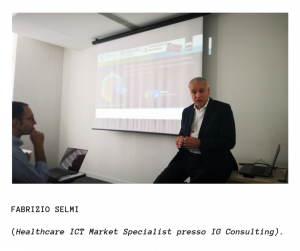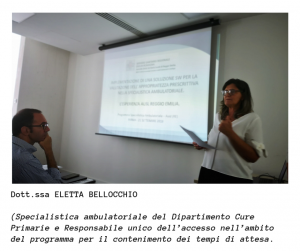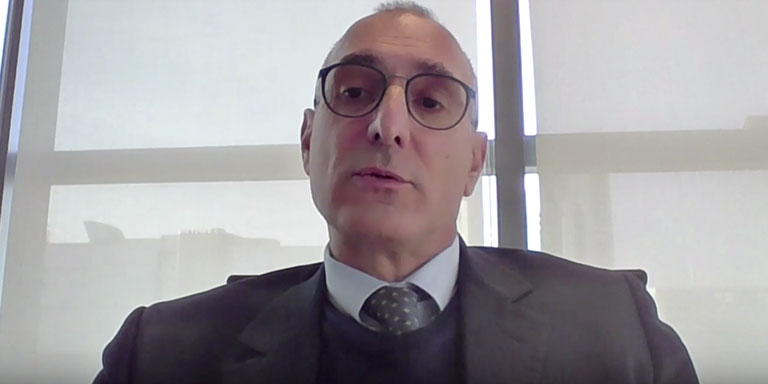
On 21 September 2018, a meeting was held in the headquarters of Maps to bring together industry workers after five years of product life and product use.
An opportunity for dialogue on Clinika and prescription appropriateness, to relay experiences from the field and encourage exchange among industry workers, after the first five years of life and use of the product that identifies potential prescription excesses in healthcare facilities with the objective of reducing costs and improving the efficiency of clinical governance.
On 21 September 2018, a meeting was held in the Parma offices of MAPS group with users of the Clinika solution and potential future users. Fabrizio Selmi, Healthcare ICT Market Specialist with IG Consulting, introduced the meeting with a presentation of the Clinika solution to all the participants. This was followed by speeches
- from national health service facilities (AUSL and AUSLL) already using the product, who illustrated their experiences,
- and IG Consulting, who presented some new features regarding Clinika based solutions.
Reggio Emilia health service: implementation of a SW solution for assessment of Prescription Appropriateness in outpatient clinics.
The Reggio Emilia AUSL (Local Health service) was represented by Dr. Eletta Bellocchio (Outpatient clinic of the Primary Care Department and Director of admission for the waiting time reduction programme), who illustrated a case study on the implementation of a solution for prescription appropriateness.
The Reggio Emilia Local Health service uses prescription protocols prepared by special work groups. These protocols were applied in various areas (CT scan, MRI, colonoscopy, gastroscopy, ultrasound) and gradually “prescription rules” were implemented into the system to evaluate the level of prescription appropriateness.
The analytical information thus produced, together with special sessions involving the prescribing physicians (discussion of problems, analysis of critical areas, training), has made it possible to obtain substantial improvement in the level of appropriateness and volumes of services prescribed.
In summary, the experience of the Reggio Emilia ASL (Local Health Service) indicates that “appropriateness of decisions in healthcare services is nowadays the only way to save the National Health Service without reducing services and, that, to this end, it is essential to provide professionals with opportunities for cultural growth and adequate, transparent communication to citizens“.
Messina ASP: a project for supporting Appropriate Prescription of Diagnostic Imaging tests.
The attention was then moved to the project, tested by the Messina ASP (Local Health Service), for a computerized system directly supporting physicians at the time of prescribing diagnostic imaging tests. The purpose is to help physicians prescribe the most appropriate tests, in some cases through direct consultation with Specialist Physicians.
As illustrated by Prof. Placido Romeo, Director of the Radiology Department of the Taormina Hospital, Messina ASP (Local Health Service), two actions have been implemented:
- A computerized service that interacts with physicians and guides them to the most adequate prescription;
- Creation of tools that enable collaboration between Prescribing physicians and Specialist Radiologists.
The result was unequivocal: 89% of the total number of cases supported by the service was considered valid for statistical evaluation, which revealed a potential reduction by approximately 20% in the number of prescriptions considered inappropriate.
AULSS3 Serenissima (Local Health Service – Venice) and the BOND solution.
Next was a summary of case histories presented by Fabrizio Selmi, from AULSS3 Serenissima (Local Health Service – Venice).
In this facility, the use of the BOND solution, together with a standard Clinika/Prescription appropriateness system integrated with the establishment’s Central Booking Service makes it possible to identify and preventively manage (together with the prescribing physician) cases with higher risk of inappropriateness.
ULSS9 Scaligera (Local Health Service – Verona): evaluation of Prescription Appropriateness of GPs.
The floor was then taken by Andrea Oliani, Director of IT systems of ULSS 9 Scaligera (Local Health Service – Verona).
A lot of ground has been covered since 2015, when it was decided to look for an IT system that would enable interaction with all prescribing physicians, giving them feedback on prescription appropriateness, to the selection and adoption of Clinika, which proved immediately effective and reliable.
At present:

- the total volume of prescriptions processed each month is approximately 450000;
- ten waiting list protocols have been entered into the system and monitored;
- each month reports are produced automatically for 360 physicians of the former ULSS 20 (Local Health Service – Verona).
Plans have been made for extending the system to the entire district of the new AULSS 9 Scaligera (Local Health Service – Verona) with the acquisition of all the prescriptions and monitoring of the 700 physicians in the AULSS 9 (Local Health Service) district.
Clinika QDNA and more…
To conclude the intense programme, future scenarios were explored by Lorenzo Della Sciucca, Principal Consultant with IG Consulting, in a preview presentation of the new Clinika services and solutions.
Among them, Clinika QDNA, the new software, currently in the implementation stage, designed to:
- understand the reasons for requesting a specialist referral;
- evaluate referral requests correlated with specific health problems;
- identify the reasons correlated with inappropriate prescriptions;
- during the design of a new waiting list protocol, obtain a very detailed picture of the clinical reasons based on which the establishment’s physicians are prescribing the services included in the waiting list protocol.
Innovative solutions supporting healthcare decision-making processes. This is why those who already use Clinika, and work to improve it, can claim that it is the most appropriate solution for improving clinical governance and healthcare efficiency.
Cover picture Photo by rawpixel on Unsplash 3rd picture. Photo by rawpixel on Unsplash




